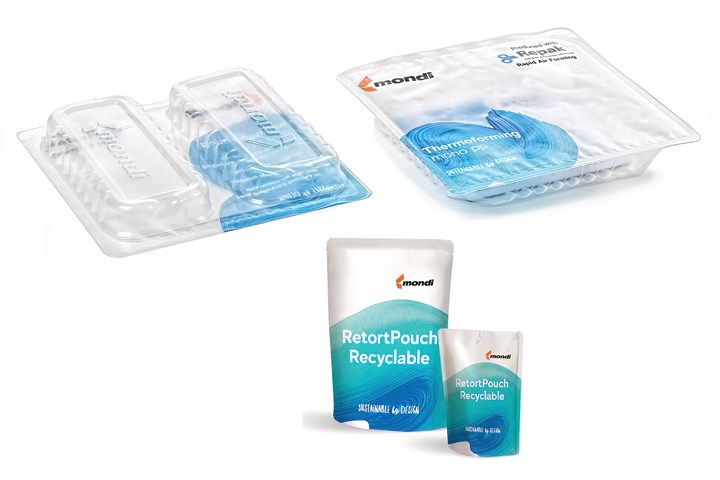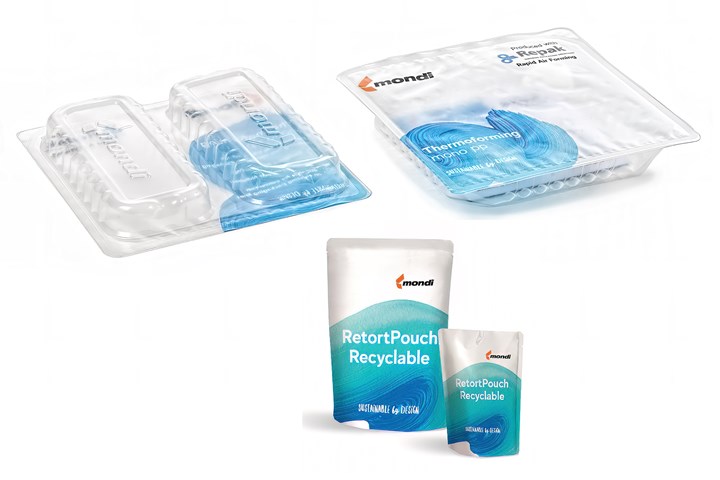
In Sustainable Packaging, the Word is ‘Monomaterial’

Exemplifying the trend to recyclable monomaterial packaging in place of hard-to-recycle multimaterial structures are these two winners of the 2023 WorldStar Global Packaging Awards in the food category: Mondi’s high-barrier MAP thermoformed tray with PP top and bottom webs; and Mondi’s all-PP retortable pouch. (Photo: Mondi)
An emailed press release crossed my desk today, which reminded me of a growing trend in the packaging world, and even outside of it. That trend is borne of developments in materials and processing technology that all monomaterial structures—usually all-PP or all-PE—to replace laminations, coextrusions and “composites” utilizing paper, aluminum, barrier resins or highly dissimilar polymers (like PET with polyolefins). The goal, of course, is increased recyclability. Unlike materials would no longer need to be separated mechanically or otherwise. Greater volumes of plastics overall would thereby be available for recovery and reuse.
This morning’s announcement exemplifies the trend: Mondi, a UK-based global producer of plastics and paper packaging, celebrated its 2023 WorldStar Global Packaging Awards — eight of them — of which two in particular caught my eye. In the food category, a winner was Mondi’s Mono Formable PP, a recyclable, high-barrier modified-atmosphere packaging (MAP) created from monomaterial PP. It has a printed PP top web and thermoformable, semirigid PP bottom web; together they weigh about 30% less than the industry standard of multimaterial, nonrecyclable PET trays.
Another winner in the food category was Mondi’s RetortPouch Recyclable, an all-PP pouch that can withstand high-temperature retort processing and can replace complex multilayer unrecyclable structures using aluminum or metalized barrier layers.
I’ve encountered the word ‘monomaterial’ quite often lately. In October, I wrote about recyclable all-PP and all-PE standup pouches introduced by Toppan, Inc. of Japan. The PP-based GL Barrier pouches, Toppan says, can replace conventional multimaterial packaging that includes aluminum foil. To be perfectly accurate, these “monomaterial” pouches are based on Toppan GL Film technologies using vapor-deposited barrier layers of aluminum oxide or silicon oxide—though these ultra-thin barrier layers reportedly have been found not to interfere with recyclability of the films.
In September, Jindal Films, an India-based global producer of packaging films, publicized its products exhibited at the FachPack 2022 show in Luxembourg. These included Metallyte metalized OPP barrier films as recyclable alternatives to nonrecyclable barrier laminates such as PET/aluminum/PE or paper/aluminum/PE; Bicor OPP films as alternatives to nonrecyclable PVDC-coated films; and new high-barrier Ethy-Lyte BOPE films (with or without metalization) as recyclable alternatives to conventional laminates of nylon or PET with PE films.
In July, another global producer of films and packaging materials, Germany-based Südpack, previewed its FachPack 2022 exhibits. These included PureLine monomaterial “Doypacks” (reclosable standup pouches) of PP as alternatives to aluminum-containing composites. Südpack also showed Multifol PurePP bottom web and Mutipeel PurePP top web for all-PP thermoformed trays.
A bit earlier, I wrote about all-PE squeeze tubes from Hoffmann Neopac, a Swiss-based global producer of plastic packaging tubes. It was said to be the first-ever fully recyclable, all-PE tube with a PE shoulder and HDPE flip-top cap in place of the usual PP hinged cap.
And shortly before that, my colleague, Senior Editor Lilli Manolis Sherman, wrote about the emergence of BOPE films as a major new contender for recyclable packaging. She cited the example of Nova’s development work on bioriented HDPE (HD-BOPE) to replace multimaterial packaging based on BOPP or BOPET.
That’s just a sampling of examples of the trend. What’s more, it extends beyond packaging. As I wrote recently, automotive and nonautomotive fuel tanks are now being blow molded in a special enhanced-barrier nylon 6, Akulon Fuel Lock from DSM Engineering Plastics, which enables monolayer fuel tanks in place of multilayer HDPE alternatives.
Read: Nova, GreenMantra Technologies Collaborate on Plastic Bag Recycling Initiative
This trend is not exactly new to automotive, where there has been a migration to all-polyolefin solutions (based mainly on PP) in place of vinyls, urethanes and styrenics to facilitate recycling.
The logic of the monomaterial trend is impeccable, in my view, and it can only continue to grow and spread.
RELATED CONTENT
-
Best Methods of Molding Undercuts
Producing plastics parts with undercuts presents distinct challenges for molders.
-
K 2013 Preview: Injection Molding
Next month’s mammoth triennial plastics show in Düsseldorf, Germany, challenges injection molding machine builders to demonstrate technological leadership in addressing the needs of the marketplace.
-
How to Dry PET for Container Applications
PET is extremely hygroscopic, highly moisture sensitive, and one of the toughest challenges to dry. Here are the basic principles of doing it right for rigid packaging applications

Leave a Reply